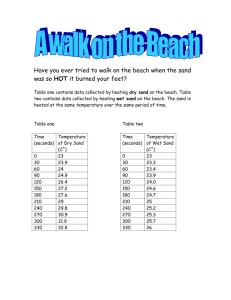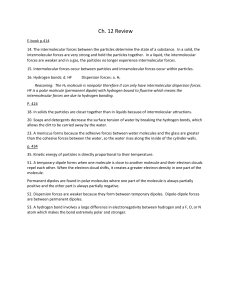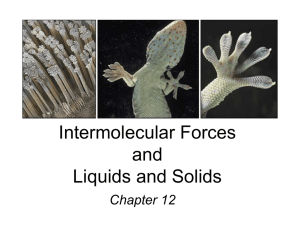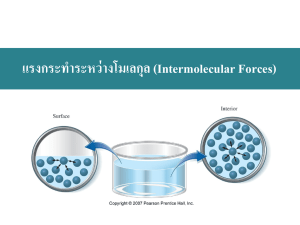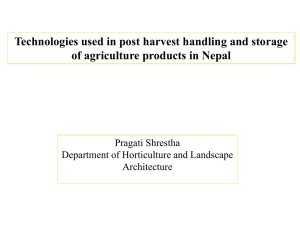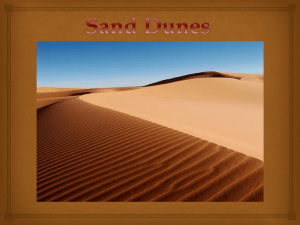Intermolecular forces lab stations
advertisement
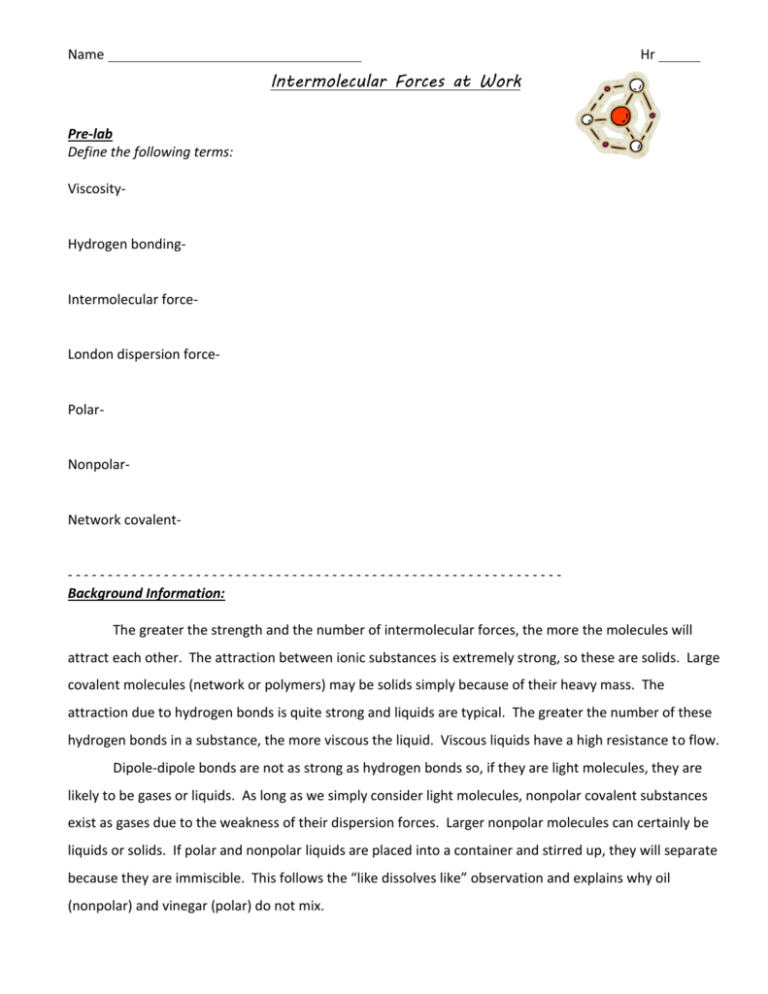
Name Hr Intermolecular Forces at Work Pre-lab Define the following terms: Viscosity- Hydrogen bonding- Intermolecular force- London dispersion force- Polar- Nonpolar- Network covalent- -------------------------------------------------------------Background Information: The greater the strength and the number of intermolecular forces, the more the molecules will attract each other. The attraction between ionic substances is extremely strong, so these are solids. Large covalent molecules (network or polymers) may be solids simply because of their heavy mass. The attraction due to hydrogen bonds is quite strong and liquids are typical. The greater the number of these hydrogen bonds in a substance, the more viscous the liquid. Viscous liquids have a high resistance to flow. Dipole-dipole bonds are not as strong as hydrogen bonds so, if they are light molecules, they are likely to be gases or liquids. As long as we simply consider light molecules, nonpolar covalent substances exist as gases due to the weakness of their dispersion forces. Larger nonpolar molecules can certainly be liquids or solids. If polar and nonpolar liquids are placed into a container and stirred up, they will separate because they are immiscible. This follows the “like dissolves like” observation and explains why oil (nonpolar) and vinegar (polar) do not mix. Station 1 - Marble Race Attempt to draw the Lewis structures for the following alcohols: Ethylene Glycol (A.K.A. antifreeze) HOCH2CH2OH Isopropyl Alcohol C3H8O Glycerol C3H5(OH)3 Flip the dry erase board over and see how close your electron dot structures were. Fix your answers. 1. In order to have hydrogen bonding (thus more intermolecular forces) you need a hydrogen and one (or more) of these elements: 2. Looking at the structural formulas for the three alcohols, which has the most hydrogen bonds? a. Which do you think is the most viscous? b. Least viscous? c. Which do you think will win the marble race? Holding the stopper in place, invert test tubes with marble and observe the speed of the marble. 3. List the fastest to slowest marble (winner loser.) 4. List the lowest to highest viscosity. 5. Describe what intermolecular forces are causing the differences in the marble speeds. Did you get the connection?? More hydrogen-bonding = intermolecular forces = to flow. Pick up the mystery colored rods rank them by weakest intermolecular forces to strongest intermolecular forces. !!!!Mix up the order before you switch stations!!!! Station 2 – Swirling Demo Each Erlenmeyer flask contains a different liquid. Work as a team and swirl all of the Erlenmeyer flasks equally at the same time. (Same speed, same time period.) Record the order that the liquids stop swirling. 1. Stopped first stopped last 2. Which of the liquids is the most viscous? 3. Which liquid has more intermolecular forces? 4. Look at the chemical structures of the molecules and draw conclusions as to which forces are acting on these liquids. Did you get the connection?? More hydrogen-bonding = intermolecular forces = to flow = stops !!!!Mix up the order before you switch stations!!!! -------------------------------------------------------------Station 3 - Covalent Molecules Observe all of the covalent molecules. Try and determine which model is diamond, which model is graphite, which model is bucky ball, and which model is ice. Confirm your guesses with the teacher. 1. What state (solid, liquid, gas) do you think these molecules are found in? Explain why you think so. 2. Diamond, graphite and bucky balls are all made of the same element. What element is represented in black? 3. Diamonds are known as the strongest substance on earth. The structure of diamonds is called network covalent because it is actually one huge molecule with interconnected atoms. Look at one of the carbon atoms in the molecule. How many intramolecular bonds come off each carbon atom? 4. Look at the structure of graphite and explain why the structure makes it useful to use in pencils. 5. Now look at the structure of ice. What is the chemical formula for water? a. What element is red? b. What element is white? c. What do the clear tubes represent in the ice model? . Station 4 – Bending Water Do not get the fur wet!! Vigorously rub the rubber rod with the fur for at least 30 seconds to build up a charge on the rod. Turn on the buret so that it provides a stream of water. Slowly bring the rod close to the stream of water, near the tip of the buret. 1. What do you notice happen to the water stream? (It will not work if you get the fur wet!!) 2. What do you think this is telling us about the polarity of water? Draw the water molecule to explain this demonstration. Include an arrow in your molecule to indicate the polarity. 3. What type of intermolecular force exists between the water molecules? 4. Do you think this demo would work with a nonpolar substance? Explain. 5. Test it out! Do the same experiment but with the cooking oil. Was it attracted? Try it a couple of times to make sure. Explain why this occurred in terms of the intermolecular forces. . -------------------------------------------------------------Station 5 – Polarity Disks There are several containers that have two different liquids in them. The cloudy looking liquid is water, which is polar, and the other liquid is nonpolar. There are circles of paper cutouts in the water. One side of these disks has been colored with graphite from a pencil. Gently shake up the bottles and observe what happens. 1. What did you observe about the direction the disks lined up after shaking? 2. For each container, determine which layer is the nonpolar substance. 3. Is the paper side of this disk polar or nonpolar? 4. Use your knowledge of intermolecular forces to explain what is meant by the phrase “like dissolves like.” 5. Relate this demo to the term miscible. Station 6 – Magic Sand DO NOT LET ANY SAND OR MAGIC SAND GET IN THE SINK! The colorful sand at this station is “magic” because it has been coated with a material used to protect upholstery from liquids and staining. Regular sand is able to form hydrogen bonds with water, magic sand cannot. Obtain two beakers of and half-fill with water. Observe the regular sand and the magic sand. Put a spoon of regular sand into one of the beakers. Observe the: shape of the sand in the water, what happens when you try to press the sand into different shapes with the spoon, and when you stir the mixture. Decant the liquid into the waste container using a stirring rod. Observe the shape of the sand and the surface of the sand that remains in the beaker. Repeat with the magic sand. 1. Describe the shape of the magic sand versus the regular sand. Compare their looks underwater. 2. What is the major type of intermolecular force in water? 3. Which type of sand was able to mix with water? Describe why using the concept of intermolecular forces. 4. Predict what would happen if dish soap had been added to the water, or if you had used oil instead. Clean up before switching. Put the regular sand in the container labeled “Wet Regular Sand” and the magic sand in the container labeled “Wet Magic Sand.” DO NOT dump in sink.



